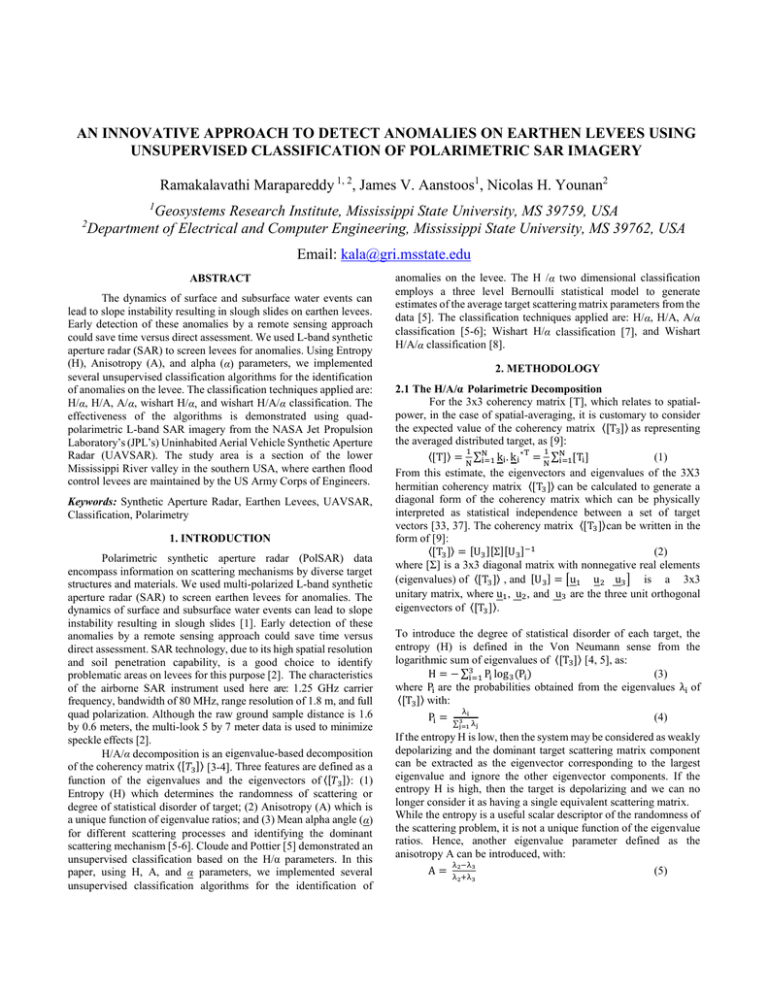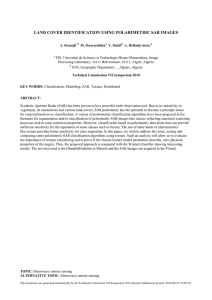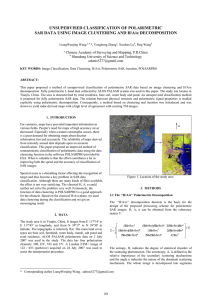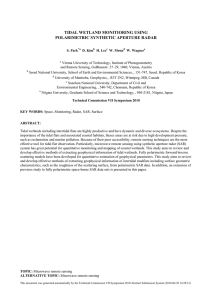AN INNOVATIVE APPROACH TO DETECT ANOMALIES ON EARTHEN LEVEES USING
advertisement

AN INNOVATIVE APPROACH TO DETECT ANOMALIES ON EARTHEN LEVEES USING UNSUPERVISED CLASSIFICATION OF POLARIMETRIC SAR IMAGERY Ramakalavathi Marapareddy 1, 2, James V. Aanstoos1, Nicolas H. Younan2 1 2 Geosystems Research Institute, Mississippi State University, MS 39759, USA Department of Electrical and Computer Engineering, Mississippi State University, MS 39762, USA Email: kala@gri.msstate.edu ABSTRACT The dynamics of surface and subsurface water events can lead to slope instability resulting in slough slides on earthen levees. Early detection of these anomalies by a remote sensing approach could save time versus direct assessment. We used L-band synthetic aperture radar (SAR) to screen levees for anomalies. Using Entropy (H), Anisotropy (A), and alpha (α) parameters, we implemented several unsupervised classification algorithms for the identification of anomalies on the levee. The classification techniques applied are: H/α, H/A, A/α, wishart H/α, and wishart H/A/α classification. The effectiveness of the algorithms is demonstrated using quadpolarimetric L-band SAR imagery from the NASA Jet Propulsion Laboratory’s (JPL’s) Uninhabited Aerial Vehicle Synthetic Aperture Radar (UAVSAR). The study area is a section of the lower Mississippi River valley in the southern USA, where earthen flood control levees are maintained by the US Army Corps of Engineers. Keywords: Synthetic Aperture Radar, Earthen Levees, UAVSAR, Classification, Polarimetry 1. INTRODUCTION Polarimetric synthetic aperture radar (PolSAR) data encompass information on scattering mechanisms by diverse target structures and materials. We used multi-polarized L-band synthetic aperture radar (SAR) to screen earthen levees for anomalies. The dynamics of surface and subsurface water events can lead to slope instability resulting in slough slides [1]. Early detection of these anomalies by a remote sensing approach could save time versus direct assessment. SAR technology, due to its high spatial resolution and soil penetration capability, is a good choice to identify problematic areas on levees for this purpose [2]. The characteristics of the airborne SAR instrument used here are: 1.25 GHz carrier frequency, bandwidth of 80 MHz, range resolution of 1.8 m, and full quad polarization. Although the raw ground sample distance is 1.6 by 0.6 meters, the multi-look 5 by 7 meter data is used to minimize speckle effects [2]. H/A/α decomposition is an eigenvalue-based decomposition of the coherency matrix ⟨[𝑇3 ]⟩ [3-4]. Three features are defined as a function of the eigenvalues and the eigenvectors of ⟨[𝑇3 ]⟩: (1) Entropy (H) which determines the randomness of scattering or degree of statistical disorder of target; (2) Anisotropy (A) which is a unique function of eigenvalue ratios; and (3) Mean alpha angle (α) for different scattering processes and identifying the dominant scattering mechanism [5-6]. Cloude and Pottier [5] demonstrated an unsupervised classification based on the H/α parameters. In this paper, using H, A, and α parameters, we implemented several unsupervised classification algorithms for the identification of anomalies on the levee. The H /α two dimensional classification employs a three level Bernoulli statistical model to generate estimates of the average target scattering matrix parameters from the data [5]. The classification techniques applied are: H/α, H/A, A/α classification [5-6]; Wishart H/α classification [7], and Wishart H/A/α classification [8]. 2. METHODOLOGY 2.1 The H/A/α Polarimetric Decomposition For the 3x3 coherency matrix [T], which relates to spatialpower, in the case of spatial-averaging, it is customary to consider the expected value of the coherency matrix ⟨[T3 ]⟩ as representing the averaged distributed target, as [9]: 1 1 ⟨[T]⟩ = ∑N k . k ∗T = ∑N [T ] (1) N i=1 i i N i=1 i From this estimate, the eigenvectors and eigenvalues of the 3X3 hermitian coherency matrix ⟨[T3 ]⟩ can be calculated to generate a diagonal form of the coherency matrix which can be physically interpreted as statistical independence between a set of target vectors [33, 37]. The coherency matrix ⟨[T3 ]⟩can be written in the form of [9]: ⟨[T3 ]⟩ = [U3 ][Σ][U3 ]−1 (2) where [Σ] is a 3x3 diagonal matrix with nonnegative real elements (eigenvalues) of ⟨[T3 ]⟩ , and [U3 ] = [u1 u2 u3 ] is a 3x3 unitary matrix, where u1 , u2 , and u3 are the three unit orthogonal eigenvectors of ⟨[T3 ]⟩. To introduce the degree of statistical disorder of each target, the entropy (H) is defined in the Von Neumann sense from the logarithmic sum of eigenvalues of ⟨[T3 ]⟩ [4, 5], as: H = − ∑3i=1 Pi log 3 (Pi ) (3) where Pi are the probabilities obtained from the eigenvalues λi of ⟨[T3 ]⟩ with: λ Pi = ∑3 i (4) j=1 λj If the entropy H is low, then the system may be considered as weakly depolarizing and the dominant target scattering matrix component can be extracted as the eigenvector corresponding to the largest eigenvalue and ignore the other eigenvector components. If the entropy H is high, then the target is depolarizing and we can no longer consider it as having a single equivalent scattering matrix. While the entropy is a useful scalar descriptor of the randomness of the scattering problem, it is not a unique function of the eigenvalue ratios. Hence, another eigenvalue parameter defined as the anisotropy A can be introduced, with: λ −λ A= 2 3 (5) λ2 +λ3 when A=0 the second and third eigenvalues are equal. The anisotropy may reach such a value for a dominant scattering mechanism, where the second and third eigenvalues are close to zero, or for the case of a random scattering type where the three eigenvalues are equal [9]. 2.2 Unsupervised wishart H/α and H/A/ α Polarimetric Classification An unsupervised classification scheme based on the use of the two-dimensional H/α classification plane, where all random scattering mechanisms can be represented. The key idea is that entropy arises as a natural measure of the inherent reversibility of the scattering data and that the alpha angle (α) can be used to identify the underlying average scattering mechanisms [9]. This classification plane is sub-divided into nine basic zones characteristic of classes of different scattering behavior as shown in Figure 1. This classification procedure was based on the comparison to fixed thresholds of the polarimetric properties of the different scattering mechanisms. The different class boundaries, in the H-α plane, have been determined so as to discriminate surface reflection (SR), volume diffusion (VD) and double bounce reflection (DB) along the α axis and low, medium and high degree of randomness along the entropy axis [5, 9]. The initial classification map defines training sets for classification based on the wishart distribution. The classified results are then used as training sets for the next iteration using the wishart method. 4. RESULTS AND DISCUSSION The PolSAR data was used for classification of scattering mechanisms of a target having a particular scattering process, such as surface, double-bounce, or volume scattering [11]. Figures 3 (ac) show the images of eigenvalue-based H/A/α decomposition parameters for (a) Entropy, (b) Alpha, and (c) Anisotropy. Figures 4 (a-f) show the images for (a) Pauli RGB Image, (b) H/α classification, (c) wishart-H/α classification, (d) H/A classification, (e) A/α classification, and (f) wishart-H/A/α classification. H/α, H/A, A/α, and wishart- H/α classification is classified into 9 classes, based on the use of the two-dimensional H/α classification plane, and wishart-H/A/α classification is classified into 16 classes based on the H/α segmentation plane [5]. The slough slide area is marked with polygon and testing area (river side of the levee) is marked with shape area on the images. The classification results reveal that the wishart-H/α and wishart-H/A/α classification method provides superior classification compared to the other unsupervised classification schemes for this application. Because for the wishartH/α and wishart-H/A/α classification, the polarimetric decomposed parameters i.e. entropy, alpha, and anisotropy are used as the training sets for the classification, and the percentage of class switching is used 10 and the number of iteration performed are 10. In addition to the true slides, marked with the polygon area on the classification results, potential future slides are also detected in the classification process. The chance of occurring slough sides are more to the river side than compared to the land side of the levee. 5. CONCLUSIONS AND FUTURE WORK Fig. 1. Segmentation of the H/α space [10]. 3. DATA AND STUDY AREA USED The fully quad-polarimetric L-band (λ = 23.98 cm) SAR imagery from the NASA Jet Propulsion Laboratory’s (JPL’s) Uninhabited Aerial Vehicle Synthetic Aperture Radar (UAVSAR) with a range bandwidth of 80 MHz was used to detect anomalies on earthen levees. A multi-polarized UAVSAR image acquired on June 16, 2009 is used for this work. We also relied on the ground truth data collected by the US Army Corps of Engineers (USACE) which documented the location and timing of slough slide appearance and repair history. The proposed algorithms were applied to a subset area of levee. The study area, as shown in Figure 2, is a section of the lower the Mississippi River valley in the southern USA. Unsupervised H/α, H/A, A/α, wishart H/α, and wishart H/A/α classification were applied to polarimetric SAR data. This work shows that slough slides on levees exhibit distinctive scattering mechanisms compared with the healthy (i.e., non-slough slide) areas, and that these differences are revealed by unsupervised classification methods utilizing the polarimetric decomposition parameters H, A, and α. The resulting color coded class maps can be used to detect anomalous areas on the levee for closer inspection. The obtained classification results reveal that the wishart-H/α and wishart-H/A/α classification method provides superior classification compared to the other unsupervised classification schemes for this application. The PolSAR multi look cross-products (MLC) data is used for classification of scattering mechanisms of a target having a particular scattering process such as surface, doublebounce, or volume scattering [11]. The effectiveness of the algorithms is demonstrated using fully quad-polarimetric L-band SAR imagery from the NASA Jet Propulsion Laboratory’s (JPL’s) Uninhabited Aerial Vehicle Synthetic Aperture Radar (UAVSAR). In future work to improve the classification results of anomaly detection on levees, we plan to test statistics-based classifiers which incorporate these features and thus benefit from their explicit representation of dominant polarimetric scattering mechanisms. ACKNOWLEDGEMENTS Fig. 2. Study area with radar color composite and subset area marked with red rectangular box. This material is based upon work supported by the National Science Foundation under Award No. OISE-1243539, and by the NASA Applied Sciences Division under grant number NNX09AV25G. The authors would like to thank the US Army Corps of Engineers, Engineer Research and Development Center and Vicksburg Levee District for providing ground truth data and expertise; and also NASA Jet Propulsion Laboratory’s for providing the UAVSAR image. Figure 3 (a-c). Entropy, alpha, and anisotropy. Figure 4 (a-c). Pauli RGB Image, H/α classification, and wishart-H/α classification. Figure 4 (d-f). H/A classification, A/α classification, and wishart-H/A/α classification. REFERENCES [1] R.B. Seed, R.G. Bea and Independent Levee Investigation Team,” Investigation of the Performance of the New Orleans Flood Protection Systems in Hurricane Katrina on August 29, 2005,” Final Report, vol. 1, part II, Chapter 10: Earthen Levee Evaluation, July 31, 2006. [2] J.V. Aanstoos, K. Hasan, C. O\'Hara, L. Dabbiru, M. Mahrooghy, R. A. A. Nobrega, and M. Lee, “Detection of Slump Slides on Earthen Levees Using Polarimetric SAR Imagery,” IEEE Applied Imagery Pattern Recognition Workshop, Washington, DC, Oct. 9-11, 2012. [3] T.L. Ainsworth, S.R. Cloude, and J.S. Lee, "Eigenvector analysis of polarimetric SAR data," IEEE International Geosci. and Remote Sens. Symposium, vol.1, pp. 626-628, 2002. [4] S.R. Cloude and E. Pottier, “A review of target decomposition theorems in radar polarimetry,” IEEE Trans. Geosci. Remote Sens., vol.34, pp. 498–518, 1996. [5] S.R. Cloude and E. Pottier, “An entropy based classification scheme for land applications of polarimetric SAR,” IEEE Trans. Geosci. Remote Sens. vol.35, pp. 68–78, 1997. [6] S.R. Cloude, E. Pottier, and W.M. Boerner, "Unsupervised image classification using the entropy/alpha/anisotropy method in radar polarimetry," In NASA-JPL, AIRSAR-02 Workshop, pp. 04-06, 2002. [7] J.S. Lee and M.R. Grunes, "Classification of multi-look polarimetric SAR data based on complex Wishart distribution." Telesystems Conference, 1992. NTC-92., National, pp. 7-21. IEEE, 1992. [8] E. Pottier and J.S. Lee, "Application of the «H/A/alpha» Polarimetric Decomposition Theorem for Unsupervised Classification of Fully Polarimetric SAR Data Based on the Wishart Distribution," In SAR workshop: CEOS Committee on Earth Observation Satellites, vol. 450, p. 335. 2000. [9] PolSARpro v4.2 (Polarimetric SAR Data Processing and Educational Tool) Software, tutorial lecture notes on Advanced Concepts, Eric Pottier, Jong-Sen Lee, Laurent Ferro-Famil, I.E.T.R-UMR CNRS 6164-University of Rennes1 and Naval Research Laboratory) at the University of Rennes 1, DLR-HR. [10] PolSARPro v4.2 (Polarimetric SAR Data Processing and Educational Tool) Software, tutorial lecture notes on Basic Concepts in Radar Polarimetry, (Wolfgang-Martin Boerner, UIC-ECE Communications, Sensing & Navigation Laboratory), at the University of Rennes 1, DLR-HR. [11] A. Freeman and S.T. Durden, “A Three-Component Scattering Model for Polarimetric SAR Data,” IEEE Trans. Geiosci. Remote Sens., vol. 36, no. 3, pp. 963-973, 1998.





